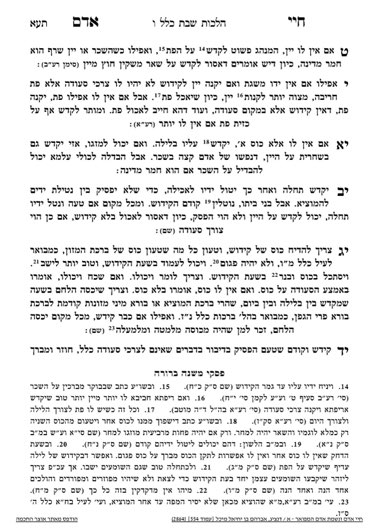The current series, which will cover Maariv on Friday night and Kiddush, is available for sponsorship. Please contact Rabbi Reingold for more information.
We are continuing in siman 13, where the Chayei Adam now discusses the halachos of covering the bread. The Chayei Adam writes that one must cover the bread, both during kiddush at night and during the day. The first reason is that normally the bracha of hamotzi (and mezonos) takes precedence to borei pri hagafen. However, over here, we are going out of order by reciting borei pri hagafen first. Therefore, the rishonim use the phrase shelo yireh hapas boshto, the bread should not be “embarrassed”, as it were, by being overlooked. Obviously, it is Chazal who are telling us to overlook the regular order of brachos, but nevertheless, it seems we are ignoring the bread, so therefore there is a reason for covering it. According to this reason, once a person has made kiddush, they no longer need to keep the challah covered. Alternatively, if they were already yotzei kiddush b’makom seudah, they would not need to cover the challah.
The second reason the Chayei Adam brings is that covering the bread is a reminder of the miracle of the man. The man would come down with a layer of dew underneath it and a layer above it. A double portion was given on Friday for Shabbos. Based on this, the Chayei Adam remarks that the cover should remain until after hamotzi.
The Chayei Adam mentioned this halacha in Klal 5, where he wrote (S0127) that ther should be two layers of covering for the challah, on bottom and on top,as a reminder of the miracle of the man. The bottom tablecloth should remain on the table all Shabbos, and the top one (the challah cover) can be removed when not needed. In Klal 5, the Chayei Adam had written that one can remove the top cloth after kiddush. According to the idea that it is as a reminder for the man, there is no reason it should be removed after kiddush. The Mishnah Berurah writes, in siman 271, that the Pri Megadim holds one can remove the top cover after kiddush, and the Chayei Adam holds that one should wait until after hamotzi. That follows what he says here, but, as noted , he says differently elsewhere. The Aruch Hashulchan says that the minhag is to keep the bread covered until after hamotzi.
Regarding Shalosh Seudos, arguably it should depend on the ideas mentioned above. If the concern is so the bread is not “embarrassed”, there is no kiddush, but if it is as a reminder for the man, that reason would apply to shalosh seudos as well. There is a third reason given by the rishonim, in the name of the Yerushalmi, that it is a kavod to the seudah for the bread to be covered until the seudah begins. Then, it is clear that the bread is being brought in honor for the meal. However, the point at which it is meant to be uncovered is unclear. The Mishnah Berurah seems to understand that, according to this reason, uncovering the bread after kiddush would be sufficient.
When it comes to shalosh seudos, it would seem that according to this third opinion, the challos should be covered until making hamotzi, since that is the beginning of the seudah. The kiddush argument does not apply, and zecher l’man would apply. Thus, there are different minhagim regarding covering the bread by shalosh seudos. The Aruch Hashulchan writes it was not the minhag to cover it, but in Telshe they were careful to cover it.
Another question is whether only the challos of the person making the brachos are covered, or do all challos have to be covered. According to the first opinion, so that the bread is not embarrassed by kiddush, it would only apply to the person making kiddush.
The Shulchan Aruch does not mention covering mezonos, but the Kitzur Shulchan Aruch mentions it. Since the bracha of mezonos also precedes hagafen, it follows the same logic as the second explanation above. It does not seem to be covered for the purpose of remembering the miracle of the man. (The Kitzur adds an opinion that one should have two pieces of mezonos, similar to lechem mishneh.)
Summary
- The person making hamotzi should keep the bread covered until the bracha.
- According to some opinions, other people should cover as well.
- There are different minhagim in regards to seuda shlishis.
- It is appropriate to cover mezonos as well.



